
Moldavia is a historical region and former principality in Central and Eastern Europe, corresponding to the territory between the Eastern Carpathians and the Dniester River. An initially independent and later autonomous state, it existed from the 14th century to 1859, when it united with Wallachia as the basis of the modern Romanian state; at various times, Moldavia included the regions of Bessarabia, all of Bukovina and Hertsa. The region of Pokuttya was also part of it for a period of time.

Neamț County is a county (județ) of Romania, in the historic region of Moldavia, with the county seat at Piatra Neamț. The county takes its name from the Neamț River.
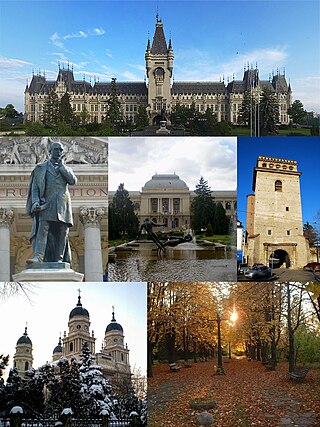
Iași, also referred to mostly historically as Jassy, is the third largest city in Romania and the seat of Iași County. Located in the historical region of Moldavia, it has traditionally been one of the leading centres of Romanian social, cultural, academic and artistic life. The city was the capital of the Principality of Moldavia from 1564 to 1859, then of the United Principalities from 1859 to 1862, and the capital of Romania from 1916 to 1918.

Stephen III, commonly known as Stephen the Great ; died on 2 July 1504), was Voivode of Moldavia from 1457 to 1504. He was the son of and co-ruler with Bogdan II, who was murdered in 1451 in a conspiracy organized by his brother and Stephen's uncle Peter III Aaron, who took the throne. Stephen fled to Hungary, and later to Wallachia; with the support of Vlad III Țepeș, Voivode of Wallachia, he returned to Moldavia, forcing Aaron to seek refuge in Poland in the summer of 1457. Teoctist I, Metropolitan of Moldavia, anointed Stephen prince. He attacked Poland and prevented Casimir IV Jagiellon, King of Poland, from supporting Peter Aaron, but eventually acknowledged Casimir's suzerainty in 1459.

Suceava is a municipality and the namesake county seat town of Suceava County, situated in the historical regions of Bukovina and Moldavia, northeastern Romania and at the crossroads of Central and Eastern Europe respectively. It is the largest urban settlement of Suceava County, with a population of 84,308 inhabitants according to the 2021 Romanian census.
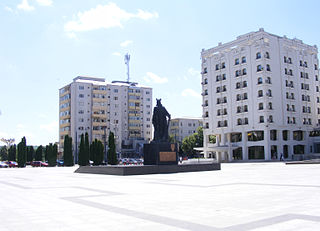
Vaslui, a city in eastern Romania, is the seat of Vaslui County, in the historical region of Western Moldavia. The city administers five villages: Bahnari, Brodoc, Moara Grecilor, Rediu, and Viișoara.

Piatra Neamț is the capital city of Neamț County, in the historical region of Western Moldavia, in northeastern Romania. Because of its very privileged location in the Eastern Carpathian mountains, it is considered one of the most picturesque cities in Romania. The Nord-Est Regional Development Agency is located in Piatra Neamț.
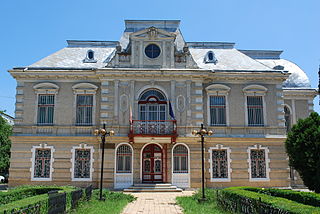
Roman is a city located in the central part of Western Moldavia, a traditional region of Romania. It is located 46 km (29 mi) east of Piatra Neamț, in Neamț County at the confluence of the rivers Siret and Moldova.

Alexander I, commonly known as Alexander the Good was Voivode of Moldavia between 1400 and 1432. He was the son of Roman I and succeeded Iuga to the throne. As ruler he initiated a series of reforms while consolidating the status of the Principality of Moldavia.

The Voroneț Monastery is a medieval monastery in the Romanian village of Voroneț, now a part of the town Gura Humorului. It is one of the famous painted monasteries from southern Bukovina, in Suceava County. The monastery was constructed by Stephen the Great in 1488 over a period of 3 months and 3 weeks to commemorate the victory at Battle of Vaslui. Often known as the "Sistine Chapel of the East" for its vivid frescoes, Voroneț's walls feature an intense shade of blue known in Romania as "Voroneț blue."
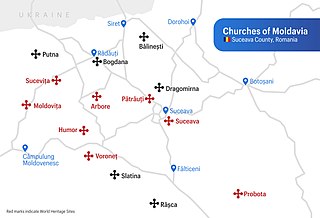
The north of the Moldavia region in Romania preserves numerous religious buildings as a testimony of the Moldavian architectural style developed in the Principality of Moldavia starting from the 14th century.

Baia is a commune in Suceava County, in the historical region of Western Moldavia, northeastern Romania with a population of 6,793. It is composed of two villages, namely Baia and Bogata. Located on the Moldova River, it was one of the earliest urban settlements in Moldavia.
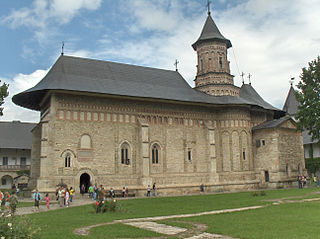
The Neamț Monastery is a Romanian Orthodox religious settlement, one of the oldest and most important of its kind in Romania. It was built in the 15th century, and it is an example of medieval Moldavian architecture. A jewel of 15th-century architecture, the church was built during the reign of Stephen III of Moldavia (1457–1504) and finished in the year when the Moldavian army won the battle against King John I Albert of Poland (1497).

The Bistrița Monastery is a Romanian Orthodox monastery located 8 km west of Piatra Neamț. It was dedicated in 1402, having as original ctitor the Moldavian Voivode Alexandru cel Bun whose remains are buried here.

Neamț Citadel is a medieval fortress located in north-eastern part of Romania, near Târgu Neamț, Neamț County. It was built in 14th century Moldavia during Petru I of Moldavia's reign and expanded in the 15th century. The citadel played a key role in Stephen III of Moldavia's defense system, along with Suceava, Hotin, Soroca, Orhei, Tighina, Chilia and Cetatea Albă.

Socola Monastery or Schimbarea la Față ("Transfiguration") was a Romanian Orthodox establishment located in the eponymous quarter of southern Iaşi, Romania. Founded during Moldavia's existence as a state, it was erected and dedicated by Moldavian Prince Alexandru Lăpuşneanu in 1562, and originally functioned as nunnery. The establishment acquired a significant historical position in Romanian education during the early 19th century, when it functioned as a seminary and the first-ever institution to provide secondary training in the Romanian language.

The Nativity of St. John the Baptist Church, located at 2 Piața Libertății, Piatra Neamț, Romania, is a Romanian Orthodox church. Established by Prince Stephen the Great of Moldavia, it was built in 1497-1498 as part of his royal court in the town. The bell tower dates to the year after the church was completed, and is a symbol of the city. Both church and tower are well preserved examples of late 15th century Moldavian religious architecture.

Moldavia, also called Romanian Moldavia, is the core historic and geographical part of the former Principality of Moldavia situated in eastern and north-eastern Romania. Until its union with Wallachia in 1859, the Principality of Moldavia also included, at various times in its history, the regions of Bessarabia, all of Bukovina, and Hertsa; the larger part of the former is nowadays the independent state of Moldova, while the rest of it, the northern part of Bukovina, and Hertsa form territories of Ukraine.
Teoctist I of Moldavia was a Moldavian cleric of the Eastern Orthodox Church.

The Moldavian vault is an architectural element of religious architecture used from the 15th to the 17th century in Moldavia. It is an arched suspension system on pendentives. It was mostly located above the naos or the main nave of the temple. The vault creates a transition from a square plane to a circular plane leading to a dome or tholobate tower. Consists of four diagonal arches over which pendentives transform square the circle. Four smaller segment arches in turn transform the circle into a square. Gradually they rise above the nave and crown the dome or tholobate tower. The vault allows a significant reduction in the diameter and weight of the tholobate, the dome and the tower itself.






































